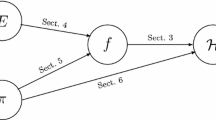Abstract
In this paper, we study the application of universal hashing to the construction of unconditionally secure authentication codes without secrecy. This idea is most useful when the number of authenticators is exponentially small compared to the number of possible source states (plaintext messages). We formally define some new classes of hash functions and then prove some new bounds and give some general constructions for these classes of hash functions. Then we discuss the implications to authentication codes.
Similar content being viewed by others
References
Bierbrauer, J., Johansson, T. Kabatianskii, G., and Smeets, B. 1994. On families of hash functions via geometric codes and concatenation.Lecture Notes in Computer Science 773:331–342.
Carter, J. L., and Wegman, M. N. 1979. Universal classes of hash functions.J. Computer and System Sci. 18:143–154.
Drake, D. A. 1979. Partial λ-geometries and generalized Hadamard matrices over groups.Canad. J. Math. 31:617–627.
Fisher, R. A.. 1940. An examination of the different possible solutions of a problem in incomplete blocks.Annals of Eugenics 10:52–75.
Plackett, R. L., and Burman, J. P. 1945. The design of optimum multi-factorial experiments.Biometrika 33:305–325.
Sarwate, D. V. 1980. A note on universal classes of hash functions.Information Processing Letters 10:41–45.
Simmons, G. J. 1984. Message authentication: a game on hypergraphsCongressus Numerantium 45:161–192.
Simmons, G. J. 1988. A survey of information authentication.Proceedings of the IEEE 76:603–620.
Stinson, D. R. 1988. Some constructions and bounds for authentication codes.Journal of Cryptology 1:37–51.
Stinson, D. R. 1990. The combinatorics of authentication and secrecy codes.Journal of Cryptology 2:23–49.
Stinson, D. R. 1992. Combinatorial characterizations of authentication codes.Designs. Codes and Cryptography 2:175–187.
Stinson, D. R. 1994. Combinatorial techniques for universal hashing.Journal of Computer and System Sci. 48:337–346.
van Trung, Tran. 1994. A combinatorial characterization of certain universal classes of hash functions.Journal of Combinatorial Designs 2:161–166.
Wegman, M. N., and Carter, J. L. 1981. New hash functions and their use in authentication and set equality.J. of Computer and System Sci. 22:265–279.
Author information
Authors and Affiliations
Rights and permissions
About this article
Cite this article
Stinson, D.R. Universal hashing and authentication codes. Des Codes Crypt 4, 369–380 (1994). https://doi.org/10.1007/BF01388651
Received:
Revised:
Issue Date:
DOI: https://doi.org/10.1007/BF01388651




